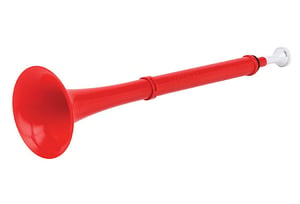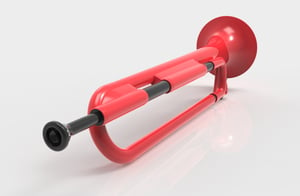Search for topics or resources
Enter your search below and hit enter or click the search icon.

 When we created the pBuzz, it was designed to make beginning a brass journey as simple as possible - especially if lead by a non-brass-playing adult.
When we created the pBuzz, it was designed to make beginning a brass journey as simple as possible - especially if lead by a non-brass-playing adult.
In order to simplify the experience as much as possible we designed the pBuzz to be a brass instrument that has only one of its many series of notes (harmonics) available to use. We chose the lowest (fundamental or pedal harmonic) as it is the easiest way to make your first sound.
The choice of this series of notes was complimented by the pBuzz mouthpiece, which is very large in comparison to the length of the instrument. What this means is that the player can only play one pitch on their pBuzz at any length of the instrument.
What this means is that it focuses players' learning on producing a good sound, articulation and learning to change pitch in small steps by changing the instrument length. pBuzz is in essence a very small trombone that plays only on its pedal range and can play the pitches F to C in concert pitch. This range is instantly transferable to a Bb or Eb trombone, or valved brass instrument.
 In comparison the pBugle focuses its attention on the other core brass skill for changing pitch; moving from one harmonic or partial to another. Compared to pBuzz the instrument is a fixed length, and it is in a concert Bb.
In comparison the pBugle focuses its attention on the other core brass skill for changing pitch; moving from one harmonic or partial to another. Compared to pBuzz the instrument is a fixed length, and it is in a concert Bb.
You may not realise it, but you will most likely be familiar with the series of notes that a bugle call uses - these are the notes of the harmonic series, and a brass player makes these sounds by controlling their lips and the air used to vibrate them.
The pBuzz has 'lower brass' (e.g trombone, tuba, euphonium) in its DNA and many 'upper brass' players (trumpet, flugelhorn, cornet), though welcoming the concept of a simple starter instrument, would prefer an instrument that is closer to 'their' instrument!
The pBugle is therefore essentially a valve-less Bb trumpet that focuses the learner's attention on good sound production, articulation and changing pitch in large steps by choosing harmonics in a trumpet-based format. The notes beginners would normally play are low Bb, F and upper Bb in concert pitch, and these notes are instantly transferable to a Bb valved instrument.
As an undergraduate Chris studied Jazz at Leeds College of Music and then became a member of the Advanced Studies, post-graduate performers course at the Royal Academy of Music and Principal Bass Trombone with the European Community Youth Orchestra under Claudio Abbado. He then spent 25 years as a busy freelance performer based in both London and the North of England working with a wide variety of ensembles and artists, including being a member of Grimethorpe Colliery Band, The British Philharmonic Orchestra, Dame Shirley Bassey’s Orchestra and the Creative Jazz Orchestra.
Alongside this Chris has worked extensively in all areas of music education, latterly as a leading deliverer and trainer in informal, large group practice. This included roles as Leader in Wider Opportunities at Hertfordshire Music Service, Leader of Instrumental Development for Derbyshire City and County Music Partnership and as a face to face trainer on the Trinity Guildhall/Open University “Whole Class Instrumental Learning” national training program.
He became a key member of the team that created pBone, the plastic trombone in 2011/12 and has been involved with pBone Music in various roles since then. Chris is currently the Director of Creativity and Innovation for the company, a role that includes overseeing product development and improvement, quality and education.